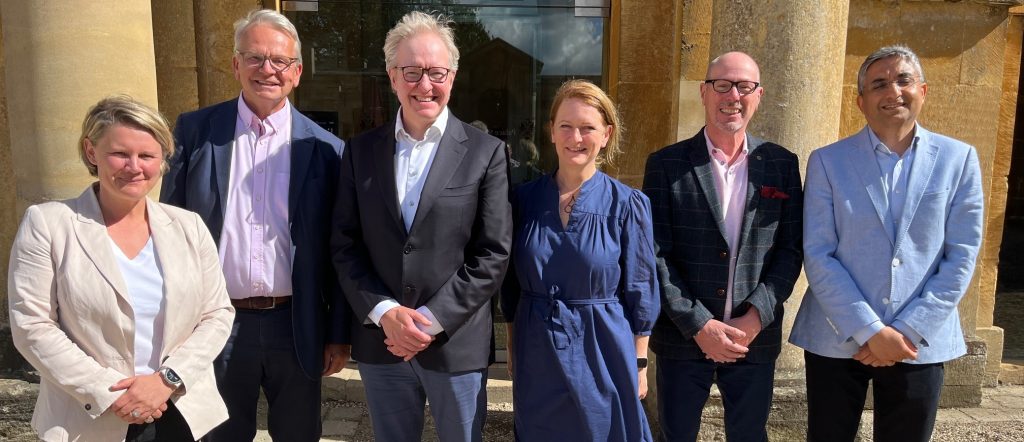Our people
Our Leadership Team
brainstrust has a stable, experienced and committed leadership team who are aligned in delivering our mission and who are the strongest advocates of our ‘people first’ vision and values. Day to day the leadership team work to promote, develop and instil purpose, autonomy and mastery throughout the organisation through a ‘tight-loose’ approach which is manifested in tightly defined objectives for each member of the team, but loosely defined method. This allows people to work the way that suits them best to achieve the right goals for brainstrust and our beneficiaries.
Will Jones– Chief Executive
Will joined brainstrust as Development Manager in 2009, having worked in strategy and account management in the publishing and marketing sectors. This included 4 years at one of the UK’s largest independent communications agencies, collaborating with clients that included Action Aid; Seven Seas; Yorkshire Forward; Yorkshire Building Society; the Department for Children Schools and Families; and UK Trade and Investment. Will became Director of Development at brainstrust in 2011, and took on the broader responsibilities of Chief Executive in October 2016.
Dr Helen Bulbeck– Founder and Director of Services and Policy
 Helen is co-founder of brainstrust and has experienced cancer as both a patient and a caregiver. She leads our Support Team and is passionate about using her experience to support the thousands of patients who have brain cancer. Her 360-degree view means that she is well placed to understand the perspectives of patients, caregivers and health care professionals; these are her key drivers with whom she interacts daily. Her ethos of ‘none of us is as smart as all of us’ is a core value for her.
Helen is co-founder of brainstrust and has experienced cancer as both a patient and a caregiver. She leads our Support Team and is passionate about using her experience to support the thousands of patients who have brain cancer. Her 360-degree view means that she is well placed to understand the perspectives of patients, caregivers and health care professionals; these are her key drivers with whom she interacts daily. Her ethos of ‘none of us is as smart as all of us’ is a core value for her.
Kathy Springate– Head of Finance
Kathy has worked in finance for over 40 years, including 20 years in the Treasury Division of Lloyds Bank plc. She joined brainstrust in 2016 as Finance Administrator, and brings a range of experience to brainstrust working closely alongside the Trust Administrator to ensure the production of accurate & timely accounts conforming to the statutory requirements.
Our team
The leadership team support the wider team of brainstrust experts and specialists in delivering our vital work.

“Working for brainstrust is hugely satisfying. We’re there to support people at any stage on their brain tumour journey, and every day, I see and hear how much this support means. At brainstrust we all work together as a team with a common goal”
Carol Cochrane, brainstrust Support Specialist
Carol Cochrane – Support Specialist
Kieran Robinson – Communications and Community Fundraising Assistant
Rebecca Cheriyan – Resources Officer
Jodie Eveleigh – Head of Support
Mariel Compton-James – Support Specialist
Adam Thomson – Impact Officer
Catherine Fitton – Designer
Ellie Baker – Support Specialist
David Lavelle – Communications Manager
Roz Walton – Grants and Trusts Fundraising Manager
Steph Coffey – Senior Fundraising Officer
Ashley Hawkins – Fundraising Events Manager
Karen Egerton – Finance and Governance Officer
Beth Shirley – Beneficiary Events Officer
Our Trustees
‘We believe good governance is an essential component of our success, particularly as we grow. It underpins our integrity, reinforces the trust and confidence our patients and partners place in us, and contributes to a strong high-performance culture.’
Chris Baker – Chair of Trustees. Chris is Managing Director for Europe, Middle East and Africa at a global technology company and has over 20 years’ experience driving growth and managing change at some of the highest-profile software companies in the world including Microsoft, Salesforce, and SAP. Chris has a technology MSc from the University of Sussex and a BA(Hons) in Philosophy and Psychology from Keele University, and has has been Chair of Trustees at brainstrust for over four years.
Mary Barrington-Ward – is a senior communications consultant and strategist with extensive experience in international and national healthcare communications across charities and healthcare communication agencies. Drawn to purpose-led organisations, such as brainstrust, she is interested in health policy and patient-led programmes, exploring how to positively support people and their families living with and through challenging health conditions. She joined the board in May 2025.
Charlotte Davies – Charlotte is a communications consultant and executive coach with a background in the public sector and the pharmaceutical industry. Having seen the impact of a glioblastoma on a close friend and their family, she was drawn to brainstrust’s mission and the opportunity to help shape its future strategic direction, impact and growth. She joined the board in May 2025.
Kevin Higgs – Kevin works in finance and has been a trustee for nearly 10 years. A chance meeting whilst at a previous employer, Kevin was immediately taken by the dedication and commitment of the charity to focus on the support and well-being of patients and families diagnosed with a brain tumour. Kevin knew immediately that he wanted to be a part of the “journey” that brainstrust has been on since 2006.
Stephen Warrington – Stephen brings to the organisation extensive experience leading professional services businesses and consulting for major multinationals. Stephen’s teenage son was diagnosed with a brain tumour and underwent successful surgery.
Puneet Plaha – Puneet is a consultant neuro-oncology surgeon in Oxford, with a specialist interest in brain tumours, especially endoscopic minimally invasive surgery and awake surgery. Puneet advocates for effective patient engagement with clinical research and he support brainstrust’s mission with PRIME, to ensure that the patient perspective is suitable acknowledged and valued so that ultimately more research can take place and be meaningful for the patient community.
Jack Jarvis – Serving British Army Commando, and record setting transatlantic solo rower, Jack brings tenacity, energy and a high-performance mindset to our board. Jack is an ardent and successful fundraiser, motivated by personal experience of a glioblastoma in his family, as well as his by his own experience navigating a complex rehabilitative journey after a serious accident. He joined the board in January 2024.

Stephen Venables, mountaineer and brainstrust patron. Photo taken on Mount Everest 1988 (c) Ed Webster
Our patrons
Peter Black, MD, PhD, FACS– Professor of Neurosurgery, Harvard Medical School, Children’s Hospital Boston and The Brigham and Women’s Hospital
Andrew McEvoy, MB, BS, BSc(Hons), MD, FRCS(Eng), FRCS(SN)– Consultant Neurosurgeon, National Hospital of Neurology and Neurosurgery
Paul Grundy, FRCS– Consultant Neurosurgeon, Wessex Neurological Centre
Stephen Venables– mountaineer, explorer, writer, broadcaster and public speaker
‘the brainstrust’ – Our patient and caregiver advisory panel
All our work is produced collaboratively with our team of patients, caregivers and healthcare professionals, known as ‘the brainstrust’.
This team oversees and contributes to the development of activity and is a sounding board for new initiatives. This ensures that our activity is relevant and meaningful for our community.
Each information project on which we embark has its own team hand-picked from the brainstrust. These teams are formed carefully so that conflict of interest is avoided and so that the patients, their caregivers and clinicians with the most relevant experiences are called upon for insight.
Currently 46 experts give their time and expertise freely to ‘the brainstrust’: 23 volunteer members represent the clinical community; 12 are patients; and 11 are caregivers. The clinical community has a broad reach and includes the following roles:
Specialist nurse
Consultant neurologist
Medical oncologist
Consultant neurosurgeon
Scientific adviser
Clinical psychologist
Consultant palliative care specialist
Expert coach, consultant and trainer
Clinical fellow
Radiation oncologist
Clinical specialist radiographer
Psychotherapist
Consultant clinical oncologist
Professor of targeted therapy and oncology
Senior nurse specialist, stereotactic radiosurgery
Therapeutic radiographer
Advanced nurse practitioner, late effects
Teenage and young adult therapy radiographer
Our high profile supporters
Everyone one of our supporters is very special, but we also have a few that you might know:
David Gower- Cricketer and commentator
Tiff Needell- Racing driver and presenter
Andrew Norris- Children’s author and TV screenwriter
Toby Jones- Successful actor and writer
Julie Walters- Actress and star of our Radio 4 appeal. Julie comes to brainstrust having experienced the effect that brain tumours can have whilst playing Mo Mowlem in the TV drama, Mo
Julian Fellowes – Baron Fellowes of West Stafford DL is a revered English actor, novelist, film director and screenwriter, and a Conservative Peer of the House of Lords. Lord Fellowes joined brainstrust at Knightsbridge Barracks as part of our ‘evening with’ series of events, raising over £20,000 for our work.
Julia Somerville – Newsreader Julia Somerville presents our 2016 BBC Lifeline appeal, and shares her own experiences of living with and beyond a brain tumour.
Gabby Allen – Reality TV star and fitness instructor Gabby Allen knows first-hand the benefit of brainstrust support, as her father, Mike, was diagnosed with a GBM in 2012. He reached out to brainstrust to get support for his family:
“brainstrust were so helpful with my dad – they knew it wasn’t just about him and his illness, but how it affected everyone around him as well. That’s what my dad loved about the charity, it was a whole family matter, and it was about the person, not the patient. So he trusted them enough to know that we weren’t on our own.” – Gabby Allen
Gabby has since become a powerful ambassador for our community, promoting wellbeing and using her immense following to raise funds and awareness.







